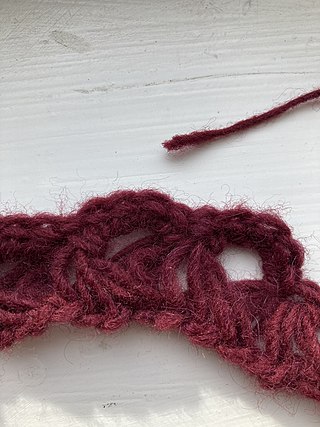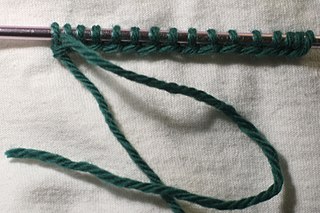Related Research Articles
Crochet is a process of creating textiles by using a crochet hook to interlock loops of yarn, thread, or strands of other materials. The name is derived from the French term croc, which means 'hook'. Hooks can be made from a variety of materials, such as metal, wood, bamboo, bone or even plastic. The key difference between crochet and knitting, beyond the implements used for their production, is that each stitch in crochet is completed before the next one is begun, while knitting keeps many stitches open at a time. Some variant forms of crochet, such as Tunisian crochet and broomstick lace, do keep multiple crochet stitches open at a time.

Knitting is a method for production of textile fabrics by interlacing yarn loops with loops of the same or other yarns. It is used to create many types of garments. Knitting may be done by hand or by machine.

Tatting is a technique for handcrafting a particularly durable lace from a series of knots and loops. Tatting can be used to make lace edging as well as doilies, collars, accessories such as earrings, necklaces, waist beads, and other decorative pieces. The lace is formed by a pattern of rings and chains formed from a series of cow hitch or half-hitch knots, called double stitches, over a core thread. Gaps can be left between the stitches to form picots, which are used for practical construction as well as decorative effect.

Filet crochet is a type of crocheted fabric that imitates filet lace. This type of crocheted lace is gridlike because it uses only two crochet stitches: the chain stitch and the double crochet stitch. Old filet patterns used a treble or triple stitch vertically but chained two between the vertical stitches. This was to prevent distortion of some patterns. Chain stitches use less yarn than double crochet stitches, which results in a visual difference in appearance between the two kinds of stitch. Filet crochet forms patterns by filling in parts of a mostly chain stitch mesh with double crochet stitches. Filet crochet is usually constructed from monotone crochet thread made of Mercerised cotton in white or ecru, and worked in rows. Filet crochet is often used for decorative applications, such as window curtains, tablecloths, and place settings, such as coasters and placemats, but can also be used to create clothing, including yokes, as well as accessories and small bags.

Tunisian crochet or Afghan crochet is a type of crochet that uses an elongated hook, often with a stopper on the handle end, called an Afghan hook. It is sometimes considered to be a mixture of crocheting and knitting. As such, some techniques used in knitting are also applicable in Tunisian crochet. One example is the intarsia method.
A crochet hook is an implement used to make loops in thread or yarn and to interlock them into crochet stitches. It is a round shaft pointed on one end, with a lateral groove behind it. The point eases the insertion of the hook through the material being crocheted and the groove makes it possible to pull a loop back through the material. The shaft is then divided into a working area that determines the hook's nominal diameter and ensures the uniform sizing of the loops formed on it, and a handle.

Circular knitting or knitting in the round is a form of knitting that creates a seamless tube. Work in the round is begun by casting on stitches as for flat knitting but then joining the ends of that row of stitches to form a circle. Knitting is worked in rounds, which forms the tube by winding around in a helix.

Broomstick lace, also known as jiffy lace and peacock eye crochet, is a historic crochet technique from the 19th century made using a crochet hook and another long slender item such as a knitting needle. Traditionally a broomstick was used, hence the name, but the modern variant is a lightweight plastic knitting needle or smooth wooden craft dowel. A larger knitting needle or dowel will result in a lacier effect, while a smaller will provide a more closely woven effect. The technique is used to make clothing, blankets, and other crocheted items. In most crochet techniques, each stitch is finished before beginning the next. Broomstick lace is different; like in knitting and Tunisian crochet, many stitches are left open for broomstick lace.

Hairpin lace is a lace-making technique that uses a crochet hook and two parallel metal rods held at the top and the bottom by removable bars. Historically, a metal U-shaped eponymous hairpin was used.

An afghan is a blanket or shawl, usually knitted or crocheted. It is sometimes also called a "throw" of indeterminate size. Afghans are often used as bedspreads, or as a decoration on the back of couches or chairs.

Amigurumi is the Japanese art of knitting or crocheting small, stuffed yarn creatures. The word is a compound of the Japanese words 編み ami, meaning "crocheted or knitted", and 包み kurumi, literally "wrapping", as in 縫い包み nuigurumi "(sewn) stuffed doll". Amigurumi vary in size and there are no restrictions about size or look. While the art of amigurumi has been known in Japan for several decades, the craft first started appealing to the masses in other countries, especially in the West, in 2003. By 2006, amigurumi were reported to be some of the most popular items on Etsy, an online craft marketplace, where they typically sold for $10 to $100.

In knitting, casting on is a family of techniques for adding new stitches that do not depend on earlier stitches, i.e., having an independent lower edge. In principle, it is the opposite of binding off, but the techniques involved are generally unrelated.
Knitting abbreviations are often used for brevity in describing knitting patterns.

A picot is a loop of thread created for functional or ornamental purposes along the edge of lace or ribbon, or crocheted, knitted or tatted fabric. The loops vary in size according to their function and artistic intention.
The manufacture of textiles is one of the oldest of human technologies. To make textiles, the first requirement is a source of fiber from which a yarn can be made, primarily by spinning. The yarn is processed by knitting or weaving, which turns yarn into cloth. The machine used for weaving is the loom. For decoration, the process of colouring yarn or the finished material is dyeing. For more information of the various steps, see textile manufacturing.

A granny square is a piece of square fabric produced in crochet by working in rounds from the center outward. Granny squares are traditionally handmade as crochet and cannot be manufactured by machine. They resemble coarse lace. Although there is no theoretical limit to the maximum size of a granny square, crocheters usually create multiple small squares and assemble the pieces to make clothing, purses, Afghan blankets, and other household textiles.

A shell stitch is a crochet motif often used as a border around other patterns or in staggered rows to create a distinctive fabric pattern. Shell stitches take the shape of arcs and semicircles, hence the name. Shell stitches are often used as edging for crocheted items such as Afghan blankets and sweaters.
Hand knitting is a form of knitting, in which the knitted fabric is produced by hand using needles.

In the textile arts, a stitch is a single turn or loop of thread, or yarn. Stitches are the fundamental elements of sewing, knitting, embroidery, crochet, and needle lace-making, whether by hand or machine. A variety of stitches, each with one or more names, are used for specific purposes.

Tapestry crochet is sometimes called jacquard crochet, intarsia, mosaic, fair isle, and colorwork, but today these terms usually describe different techniques. Since the yarns are switched back and forth to create motifs, tapestry crochet fabric looks more like it was woven on a loom than crocheted with a hook.
References
- 1 2 3 Brittain, Susan; Manthey, Karen (8 March 2011). Crocheting For Dummies. John Wiley & Sons. p. 21. ISBN 978-1-118-05334-8.
- ↑ Milne, Stephanie J. (2011). Handmade Style Crochet. Allen & Unwin. p. 10. ISBN 978-1-74266-598-6.
- ↑ Sims, Darla (2000). Crocheting for Fun and Profit. Prima Pub. p. 18. ISBN 978-0-7615-2161-7.
